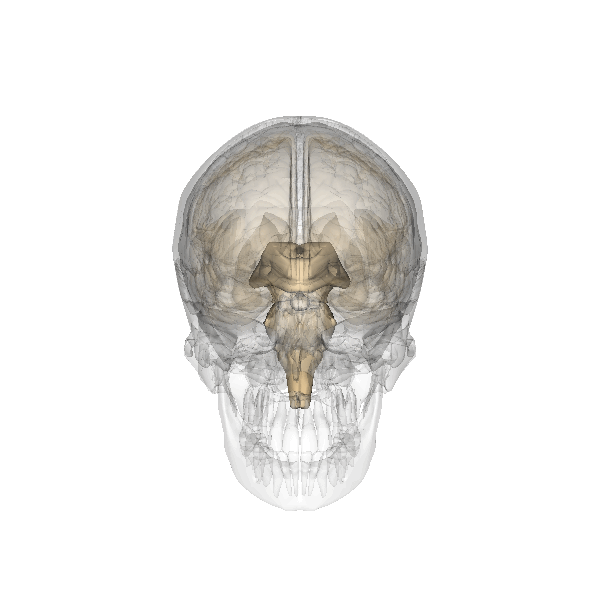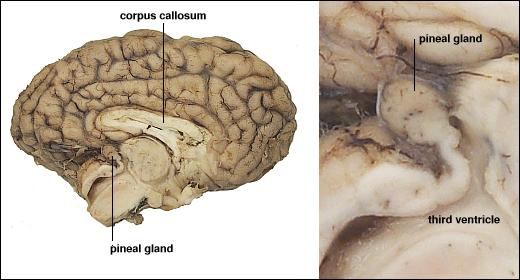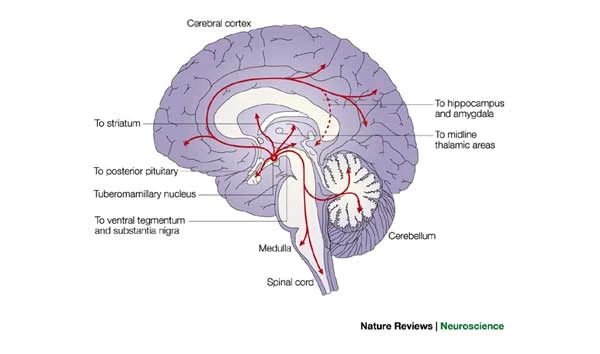2020-09-30 09:44:21
Prelude (01:57)
Announcements
- Quiz 2 next Thursday
- Blog post 1 (of 3) due next Thursday
Today’s Topics
- Warm-up
- Neurotransmitters
- Hormones
Warm-up
The presynaptic influx of which ion triggers the release of neurotransmitters from the axon terminal?
- Na+
- K+
- Ca++
- Cl-
The presynaptic influx of which ion triggers the release of neurotransmitters from the axon terminal?
- Na+
- K+
- Ca++
- Cl-
This type of postsynaptic receptor does NOT contain its own ion channel.
- Ionotropic
- Metabotropic
- Ligand-gated
This type of postsynaptic receptor does NOT contain its own ion channel.
- Ionotropic
- Metabotropic
- Ligand-gated
Which neurotransmitter is released at the largest number of synapses in the CNS?
- Glutamate
- GABA
- Acetylcholine
- Dopamine
Which neurotransmitter is released at the largest number of synapses in the CNS?
- Glutamate
- GABA
- Acetylcholine
- Dopamine
More on neurotransmitters
Monoamine neurotransmitters
| Family | Neurotansmitter |
|---|---|
| Monoamines | Dopamine (DA) |
| Norepinephrine (NE)/Noradrenaline (NAd) | |
| Epinephrine (Epi)/Adrenaline (Ad) | |
| Serotonin (5-HT) | |
| Melatonin | |
| Histamine |
Monoamine Song
Monoamine Song
Monoamines, do-do do do-do Monoamines, do do do-do Monoamines, do do do do-do do do-do do do-do do do do do-do do
Monoamine Song
Monoamines, do-pa-mine is one Monoamines, norepi, too Monoamines, sero-tonin e-pinephrine, dop-a- mine, nor-epinephrine, melatonin, whoo!
Monoamine Song
Monoamines, mod-u-late neurons Monoamines, throughout the brain Monoamines, keep people happy, brains snappy, not sleepy, not sappy, do-do do-do do-do do
Monoamine neurotransmitters
| Family | Neurotansmitter |
|---|---|
| Monoamines | Dopamine (DA) |
| Norepinephrine (NE)/Noradrenaline (NAd) | |
| Epinephrine (Epi)/Adrenaline (Ad) | |
| Serotonin (5-HT) | |
| Melatonin | |
| Histamine |
Dopamine (DA)
- Released by two pathways that originate in the midbrain tegmentum
- Substantia nigra -> striatum, meso-striatal projection
- Ventral tegmental area (VTA) -> nucleus accumbens, ventral striatum, hippocampus, amygdala, cortex; meso-limbo-cortical projection
DA pathways
DA Disruption linked to
- Parkinson’s Disease (mesostriatal)
- DA agonists treat (agonists facilitate/increase transmission)
- ADHD (mesolimbocortical)
- Schizophrenia (mesolimbocortical)
- DA antagonists treat
- Addiction (mesolimbocortical)
DA Inactivated by
- Dopamine transporter (DAT)
Dopamine receptors
| Type | Receptor | Comments |
|---|---|---|
| Metabotropic | D1-like (D1 and D5) | more prevalent |
| D2-like (D2, D3, D4) | target of many antipsychotics (drugs that treat schizophrenia symptoms) |
Norepinephrine (NE)
- Role in arousal, mood, eating, sexual behavior
- Released by
- locus coeruleus in pons/caudal tegmentum
Locus coeruleus
Sympathetic Nervous System
- NE released onto target tissues
NE and monoamine oxidase
- Monoamine oxidase inactivates monoamines in neurons, astrocytes
-
Monoamine oxidase inhibitors (MAOIs) increase NE, DA
- Inhibiting inactivation ~
-(-1) = + 1
- Inhibiting inactivation ~
- Treatment for depression, but side effects (dry mouth, nausea, headache, dizziness)
NE Anatomy
NE receptors
| Type | Receptor | Comments |
|---|---|---|
| Metabotropic | \(\alpha\) (1,2) | antagonists treat anxiety, panic |
| \(\beta\) (1,2,3) | ‘beta blockers’ in cardiac disease |
Serotonin (5-HT)
- Released by raphe nuclei in brainstem
- Role in mood, sleep, eating, pain, nausea, cognition, memory
- Modulates release of other NTs
- Most of body’s 5-HT regulates digestion
- Enteric nervous system
5-HT anatomy
5-HT receptors
- Seven families (5-HT 1-7) with 14 types
- All but one metabotropic
5-HT clinical significance
- Ecstasy (MDMA) disturbs serotonin
- So does LSD
- Fluoxetine (Prozac)
- Selective Serotonin Reuptake Inhibitor (SSRI)
- Inhibits reuptake -> increases extracellular concentration
- Treats depression, panic, eating disorders, others
5-HT clinical significance
- 5-HT3 receptor antagonists are anti-mimetics used in treating nausea
Melatonin
- Hormone released by pineal gland into bloodstream
- Concentrations vary over the day, peak near bedtime
- Release regulated by inputs from hypothalamus
Pineal gland

By Images are generated by Life Science Databases(LSDB). - from Anatomography, website maintained by Life Science Databases(LSDB). You can get this image through URL below. 次のアドレスからこのファイルで使用している画像を取得できます URL., CC BY-SA 2.1 jp, https://commons.wikimedia.org/w/index.php?curid=7855244
Histamine
- In brain, released by hypothalamus, projects to whole brain
- Metabotropic receptors
- Role in arousal/sleep regulation
- In body, part of immune response
Histamine
Other NTs
- Gases
- Nitric Oxide (NO), carbon monoxide (CO)
- Neuropeptides
- Substance P and endorphins (endogenous morphine-like compounds) have role in pain
- Orexin/hypocretin, project from lateral hypothalamus across brain, regulate appetite, arousal
Other NTs
- Neuropeptides (continued)
- Cholecystokinin (CCK) stimulates digestion
- Oxytocin and vasopressin released by posterior hypothalamus onto posterior pituitary, regulate social behavior
Non-chemical communication between neurons
- Gap junctions
- Electrical coupling
- Connect cytoplasm directly
- Fast, but fixed, hard to modulate
- Examples, retina, cardiac muscle
Gap junctions
Ways to think about synaptic communication
- Specificity: point-to-point vs. broadcast
- Direct (immediate) action vs. (delayed, prolonged) modulatory
- Agonists vs. antagonists
Agonists vs. Antagonists
- Agonists
- bind to receptor
- mimic action of endogenous chemical
- Antagonists
- bind to receptor
- block/impede action of endogenous chemical
Valium is a GABA-A receptor agonist. This means:
- It decreases inhibition
- It activates a metabotropic Cl- channel
- It facilitates/increases inhibition
- It blocks an ionotropic channel
Valium is a GABA-A receptor agonist. This means:
- It decreases inhibition
- It activates a metabotropic Cl- channel
- It facilitates/increases inhibition
- It blocks an ionotropic channel
Next time…
- Hormones







